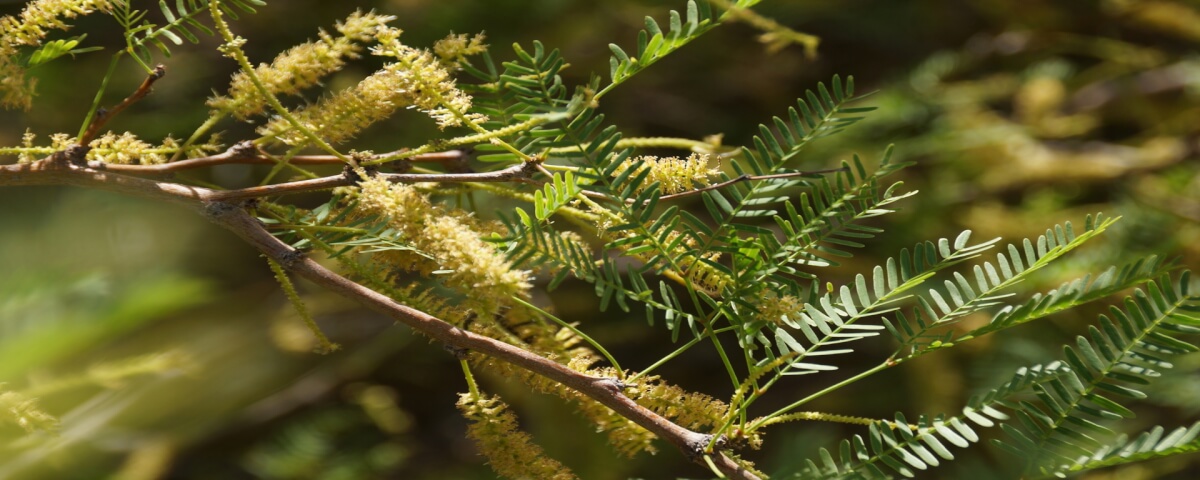If you’ve ever driven through the low desert in the area of Palm Springs, California, you’ve undoubtedly driven by some of the common mesquite plants (Prosopis velutina).
The yellow pods were once used by all the indigenous inhabitants of the desert regions, usually ground into a flour and eaten. The ripe pods are sweet, and when ground into flour, can be used to make a variety of tasty and nutritious dishes.
This shrub, or one of its close relatives, can be found throughout the deserts of Southern California, southern Nevada, parts of Utah, in Arizona along the full lengths of both the Colorado and Gila Rivers, southwestern New Mexico, and even east to Texas along the Rio Grande River.
If the plant wasn’t in flower or fruit, it’s somewhat inconspicuous, and you may not have known it was mesquite. It was just one of those shrubby non-descript road or trailside plants that blends in with the landscape.
Upon closer inspection, you see that the leaf is even-pinnately divided into smaller round or linear segments, giving the plant a ferny look. There are little spines on the stems, generally two per node.
The mesquite fruits that first appear are like hanging green beans, and by supper they become pale yellow, dry, and maybe six inches long. They look like slightly withered green beans, but yellow.
“The ripe pods are sweet, and when ground into flour, can be used to make a variety of tasty and nutritious dishes.”

Mesquite Pods
The yellow pods of mesquite are the main prize of this desert shrub or tree. They are harvested when ripe, which is typically sometime in the summer. There are a number of ways in which the pods have been used for food over the centuries.
Perhaps one of the simplest is to just pick the mature pods, chew it, and spit out the seeds. (The screwbean is used similarly). Traditionally, the whole pods would be ground into a flour by the desert Indians which was then used alone or mixed with other flours in order to make breads and cakes.
Paul Campbell is the author of “Survival Skills of Native California” and loved the flour made from mesquite. If he couldn’t gather enough on his travels to the desert, he would have some of his Seri Indian friends from the desert send him some.
Screwbean vs. Mesquite
One of the close relatives of the mesquite is the screwbean (Prosopis pubescens). When not in flower or fruit, mesquite and screwbean are very hard to discern. But when in fruit, the screwbean is just as the name implies: a bean that looks like you twisted it.
It’s somewhat shorter than the mesquite fruit, and round in the cross section. Like mesquite, screwbean can be eaten and provides a great source of fiber, sugar, and protein. It can even be brewed in place of coffee.



Mesquite Tea
Once when I visited Campbell, he served me a drink and asked me to guess what I was drinking. I took a slow sip of the very sweet warm drink, and made four (wrong) guesses as he laughed.
It turned out that he simply brewed some of the pounded mesquite meal in hot water, and poured off the dark liquid into my cup. It was absolutely delicious, one that even the most finicky and discriminating eaters will rave about.
The leaves of the mesquite can be dried, powdered, and applied directly to cuts and scrapes to reduce inflammation, and even stop minor bleeding. A tea made from an infusion of the leaves has been used effectively to treat sunburns, rashes, and insect bites.
This tea can also be used as a gargle for mouth sores or sore throats. Though often overlooked as merely a tree covered in pods or as a great wood to add flavor to meat, mesquite can offer a wholesome and tasty surprise when broken open, ground, and eaten.
Family Species Data
Mesquite is a member of the Legume Family (Fabaceae), which is a big family world-wide. This family has about 730 genera and 19,400 species. In California, this large group is represented by 50 genera. One genus in this group is Prosopis.
There are 44 species of Prosopisworldwide, with three found in California and the surrounding areas. One of those is mesquite, Prosopis glandulosa. Another species is the screwbean (P. pubescens). Both are natives of the Southwest.
A Note About the Palo Verde Pods
In the general areas where the mesquite grows, you will also find a native tree called the palo verde. Palo verde is also in the pea family, and the seeds from the pods are edible and were long-used by the desert Indians.
However, whenever this plant is mentioned, it is called a “survival food.” I have often wondered why a palatable seed should be called a “survival food.” That is similar to something like mud and bark that you’d only eat as a last resort to starvation.

Yes, the palo verde seeds are hard and require grinding, but it seems that this seed was always given second fiddle if the more desirable mesquite pod was readily available. Whereas the palo verde sees are sweet and can be eaten raw as a snack or in a salad.
Editor’s note: A version of this article first appeared in the October 2015 print issue of American Survival Guide.


